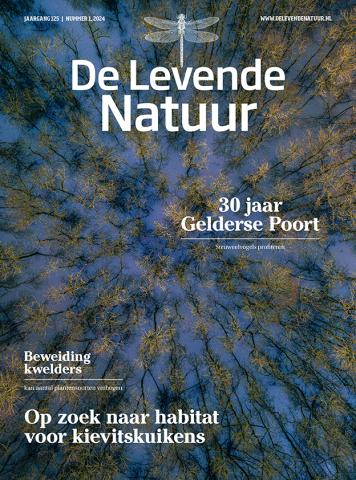De Levende Natuur nummer 1 van 2024 (English summary)
Afbeelding

Breeding birds thrive in the Gelderse Poort
Large-scale river floodplain rehabilitation started in the Netherlands 30 years ago in the Gelderse Poort, the area where the Rhine enters the country and branches off to form its current delta. Breeding birds typical of vegetations dominated by tall herbs and scrubs responded most positively, as their numbers increased much stronger compared to trends in the adjacent inner dike polders. Birds of bushes and woodlands increased as well, but breeding birds typical of water, marshland and pioneer habitats did not profit. However, these groups did succeed in reversing their initial declines into increases in one of the former river branches. Here, population recovery coincided with targeted reed marsh restoration. We conclude that rehabilitation of typical riverine bird communities is on the right track, but not yet complete. Temporal inundated floodplains during spring are an important missing link.
Mosbeek Valley recovered
The source of the Mosbeek Valley is an alkaline fen with an unique composition of vegetation types. The fen was formed due to human influence, but it was also human influence that caused a decrease in quality of the fen. An intensified land use triggered erosion that caused the stream to cut deeper in the landscape. The stream and the small ditches in the fen area caused desiccation of the peat. As a result, an alteration in species composition occurred, showing a decline of characteristic conditions for alkaline fens. Because the future of the fen became very uncertain, a restoration plan was made that included filling up the stream and ditches. The results after taking the measures in 2018 are spectacular. The water drains away diffusely now and the conditions for recovery of the peat are fulfilled. To date, there is no evidence of new erosion. The complex vegetation gradient consisting of wet heaths, species-rich grasslands, alkaline fens and alluvial forests has become more robust.
A new habitat for the northern lapwing
Northern lapwings (Vanellus vanellus) are declining in modern-day Dutch grasslands, likely due to low chick survival. To guide lapwing chick-friendly grassland management, we identified habitat characteristics selected by lapwing families and their effects on chick survival. We tracked lapwing families in seven areas using GPS transmitters and measured habitat traits weekly at points where families were present and at six fixed reference points per area. Only 7/37 families fledged any chicks and few families survived for more than two weeks. Families selected short swards, low soil resistance, high soil moisture and many small arthropods, typically with more microrelief and low vegetation productivity. Lapwing families left sites for shorter sward, higher soil moisture and more earthworms, usually travelling less than 100 m. Of all habitat characteristics, only sward height and cattle grazing correlated significantly with chick survival. Despite strong habitat selection, lapwings struggled to successfully rear chicks. Optimal conditions may lack in modern-day agricultural grasslands, particularly in dry springs. We recommend site managers to combine rewetting, extensification, extensive grazing in a cleverly designed mosaic at a sufficient scale to create optimal chick rearing conditions.
Research on 50 years of salt-marsh grazing
The salt marshes on the Frisian islands of Terschelling and Schiermonnikoog have been grazed by cattle for over a century. In the early 1970s, an experiment was started to study the impact of grazing on the vegetation. Parts of the gradient from dune to low salt marsh were excluded from grazing. Generally, the number of plant species in permanent plots of 2 x 2 m slowly decreased after exclusion of livestock as a result of taller vegetation and accumulation of litter. This did not hold entirely for Terschelling where the vegetation of the salt marsh locally remained short as result of extreme abiotic conditions such as stagnant water after inundation from the sea or heavy showers. With continued livestock grazing, the number of species slightly increased on Schiermonnikoog. Long-lasting research is rewarding: the vegetation still changes after decades. At landscape scale, we saw a decrease of the number of plant communities after exclusion of livestock.


